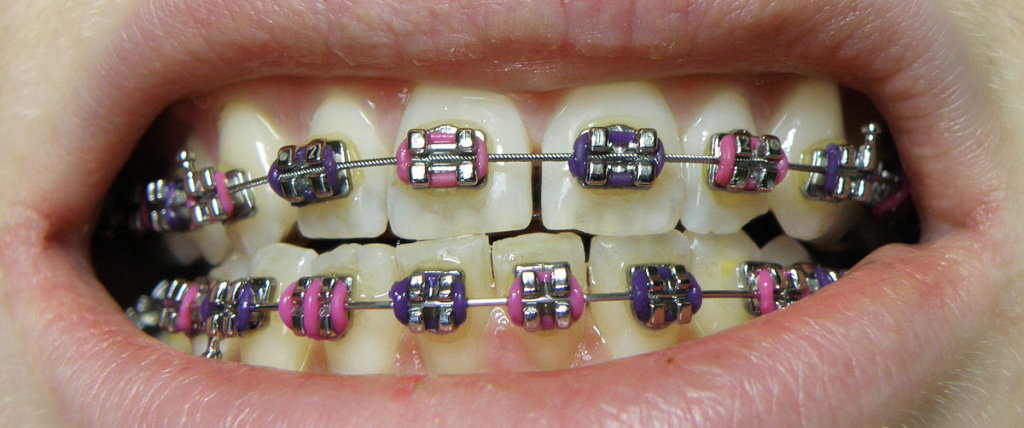are devices used in orthodontics that align and straighten teeth and help position them with regard to a person’s bite, while also aiming to improve dental health. They are often used to correct underbites, as well as malocclusions, overbites, open bites, gaps, deep bites, cross bites, crooked teeth, and various other flaws of the teeth and jaw.

Braces can be either cosmetic or structural. Dental braces are often used in conjunction with other orthodontic appliances to help widen the palate or jaws and to otherwise assist in shaping the teeth and jaws.
Price Of Braces In Mauritius
Some orthodontist will ask you to pay about Rs35,000 – Rs60,000 depending on how bad your teeth are. The total fees will be divided on how long you will be going.
TYPES OF BRACES
Metal braces/Traditional braces
These are the metal brackets and wires that most people picture when they hear the word “braces.” However, modern brackets are smaller and less noticeable than the notorious “metal-mouth” braces that many adults remember. Plus, new heat-activated archwires use your body heat to help teeth move more quickly and less painfully than in the past.

Pros: Least expensive type; colored bands give kids a chance to express themselves
Cons: Most noticeable type of braces
Ceramic Braces
Ceramic braces are the same size and shape as metal braces, except that they have tooth-colored or clear brackets that blend in to teeth. Some even use tooth-colored wires to be even less noticeable.

Pros: Less noticeable than metal braces; move teeth much faster than clear plastic aligners (Invisalign)
Cons: More expensive than metal braces; Brackets can stain easily if patients don’t care for them well.
MOST ADVANCED FOR HEALTHY GUMS DURING AND AFTER BRACES
iO Series 9 Rechargeable Electric Toothbrush, Black Onyx
The Oral-B iO Series combines powerful, but gentle micro-vibrations with Oral-B’s unique dentist-inspired round brush head design for a professional clean feeling every day.
Get a FREE Crest Whitening Emulsions with Wand Applicator ($50 value) with any Oral-B iO9 purchase, only from Oral-B. Limited quantities available and no additional discounts apply. Use code HOLIDAYS at checkout.
Lingual Braces
Lingual braces are the same as traditional metal braces, except that the brackets and wires are placed on the inside of teeth.

Pros: Invisible from outside
Cons: Difficult to clean; more expensive; not appropriate for severe cases; can be more uncomfortable at first; regular adjustments take longer and are more difficult than with traditional braces. If you’re considering this form of braces, consider switching to the Oral-B iO electric toothbrush-its unique round brush head and micro-vibrations help clean all surfaces of the tooth as you brush with 3D tracking and AI recognition.
Invisalign
Invisalign consists of a series of 18 to 30 custom-made, mouth guard-like clear plastic aligners. The aligners are removable and are replaced every 2 weeks.

Pros: Almost invisible; Patients can eat and drink whatever they want
Cons: Will not work for serious dental problems; only available for adults and teens, not children; more expensive option; can be easily lost and costly to replace; treatment may potentially take longer.
No matter which type of braces you go with, be sure to pay extra attention to your oral hygiene. Braces with wires and brackets leave teeth more vulnerable to trapped plaque and food debris, which may cause staining and possibly tooth decay. An electric toothbrush can help-the Oral-B iO features micro-vibrating bristles on a dentist-inspired round brush head to better clean tooth-by-tooth.
Another option to help keep teeth and gums clean and healthy while wearing braces is an electric toothbrush quipped with specialized brush heads like Oral-B Power Tip Brush Heads which can help remove more plaque from in-between teeth and tight spaces such as brackets and wires. And, don’t forget the floss! Oral-B Super Floss is uniquely designed to clean braces, bridges, and gaps between teeth.
With a proper oral care routine, you can reveal a straighter, healthy smile once it’s time for your braces to come off.
Are there any alternatives to braces?
Unfortunately, there aren’t many alternatives to braces, but there are alternatives to the metal braces that many people immediately picture. You can get clear or tooth-colored brackets and wires, which make braces much less noticeable. Some patients are also eligible for Invisalign instead of traditional braces. There are also other types of removable appliances that can help align teeth.
Some adults choose to get veneers instead of braces to serve as a purely cosmetic fix. However, these are quite expensive, may need to be replaced at some point in life, and do not actually correct any bite issues.
What’s the best age to get braces?
There’s no set “best” age to get braces. For most kids, the best time for braces is generally between ages 10 and 14, when a child’s mouth and head are still growing and the permanent teeth are erupting. The exact time depends on growth and on how quickly a child’s adult teeth come in. However, braces can still be effective in older teenagers and adults.
How long do people have to wear braces?
On average, most kids wear braces for 1 to 3 years, but this can vary greatly for each person based on growth and the severity of the problem. It also depends on the cooperation of the patient, including maintaining good oral hygiene, wearing auxiliaries such as rubber bands as directed, avoiding damaging food, and keeping all of their follow-up appointments.